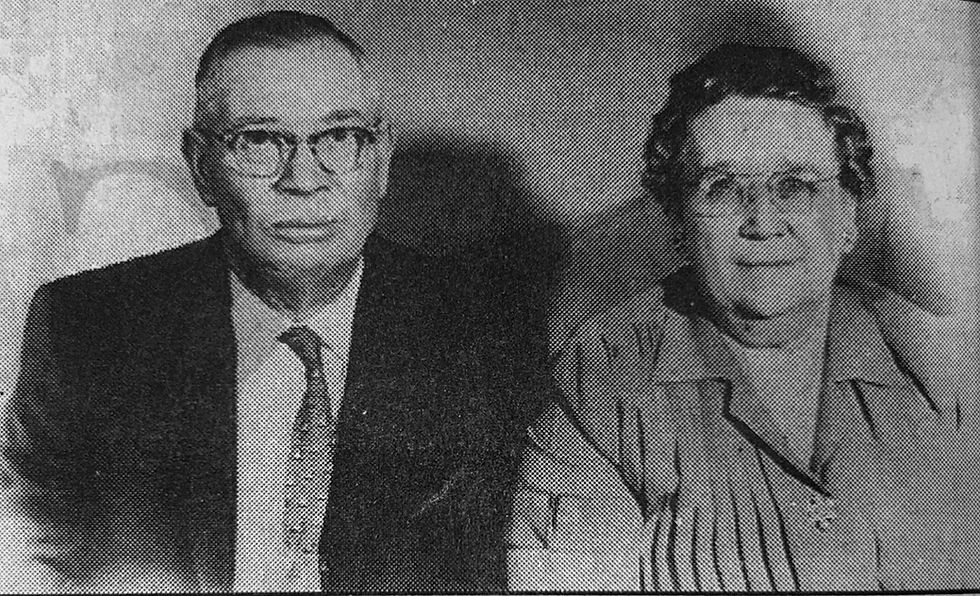Recollections: Legends of Yesterday - Bill Henley Continued
- gvnews7
- Apr 15, 2024
- 4 min read
This is a reprint of original articles by Hugh Woolley, a longtime resident and community leader of Graceville. Woolley published these articles in The Graceville News more than 20 years ago.
Originally published in the April 12, 2001 edition of The Graceville News.

In 1948 when I first came to Graceville, I noticed a unique barn located where Devondale Farm was located. It was between Campbellton and Jacob, FL. I was told that it was Bill Henley's commercial dryer. "This is where Bill did custom drying and cleaning of Lupine and Bahia seed for the growers of this area," someone replied. Although Bill had his degree from the U of Florida in animal husbandry and was hired as a livestock improvement specialist, after 5 years he could no longer resist the rural calling. He wanted to own his own farm.
The Panhandle of North Florida was still in the frontier stage as far as price of land was according to other areas of the south. I know land prices around my home area in central Alabama were 5 to 10 times higher even in 1948. Land prices caught my attention immediately. The best land could be bought for around $40 an acre in 1950 and in Washington County and Holmes County there were some sold for $9 to $10 per acre.
Mr. Nobles, president of Citizens Bank, Marianna. Fl. made it possible for Bill and his wife to purchase 1,180 plantation in 1937 which later he increased to 1400 acres. Bill with his good appearance and personality convinced the banker that he was the patron for the bank. Mr. Noble's passive attitude toward Bill immediately closed the deal.
Most of the houses were run down on the old plantation. So, Bill went to the farm and went to work on the house that he would later move his family into. Reba and the family went to Ohio with the children, her father later came down and helped Bill with the house. I remember this 2-story house just above the Jacob crossing beside the Bayline RR. Bill had several hands on the farm, and he opened the old commissary for some years.
Bill Henley's daughter put together a book about the Henley's history. Betty Ann's book on the Henley's states, "They lived in very primitive conditions for a while as there was no indoor plumbing. Water was carried from down by the barn, which seemed a block away, especially at night with no lights, and heated in the fireplace for baths. Cooking was done on a kerosene stove that had to be filled each night, to get ready for the next day. A happy осcаsion it was when Bill met the freight train in Cottondale to pick up a white Kalamazoo stove from Kalamazoo, Michigan, which later was used in the new home. Kerosene lamps furnished lights for the home."
Bill had fell in love with Devon cattle at the University of Florida. They were classified by most southern ag colleges as a general-purpose cow. They were good milkers and crossed with native cattle and were adapted well to the south. Bill, Jr., says, "Their butter fat didn't separate like Jersey milk, it was more like homogenized milk . Anyway, Bill bought 5 Devon Heifers and a bull from the University of Florida. That was the beginning of his pure-bred herd of Devon cattle.
Albert Boyd used to delight himself and others in telling this story about Bill trucking Devon cattle from New England. I'm not sure if he was talking about Bill or his trucker. Anyway, they had just loaded up with pure bred Devon cattle in New England and headed south. When they were on the outskirts of New York City the driver said to the other, “Have you ever seen the main drag of New York City?" "No," replied the other "Then let's drive through suggested the driver. The signs would say, "NO TRUCKS and "NO TURNING." So, they didn't know what to do. So they proceeded along. After awhile, they ran enter heavy traffic, when they came to a red light. Large numbers of people had not ever seen a cow began crowding around the truck. Picture this with a large traffic jam, cows mooing, and a little cop on a motorcycle rode up and cursed them out and said, "I'll put you both in jail."
"If you do then you will have to feed my cows," replied Bill. The little cop let out a few curse words and said, "You southern rednecks follow me," and he lead them through the "Big Apple".
One time, Bill put an attractive miniature Red Devon on top of his mailbox. One night some mischievous individuals painted a white face (Hereford breed) on the miniature cow. Who did this prank? Bill pointed his finger at French Mixson, Joe Otis Fillingim and Wayne Mixson. He never for sure found out who did it. Bill did the smart thing, he let it stay that way until it rotted down.
Bill was a very progressive farmer and kept up-to-date on things. 1 remember he brought in the first cotton stripper. Also, he introduced Sart Sorghum to the area that would grow 20 feet high and produce 20 tons of silage per acre.
If I was to comment on the most important thing in his life. It would be have been his acknowledgment of his religion. Although he was a Methodist, I remember him supporting the countywide tent revival by E.J. Daniels in Marianna. Bill was a legend of yesterday.
To subscribe to The Graceville News visit Pricing Plans.





Comments